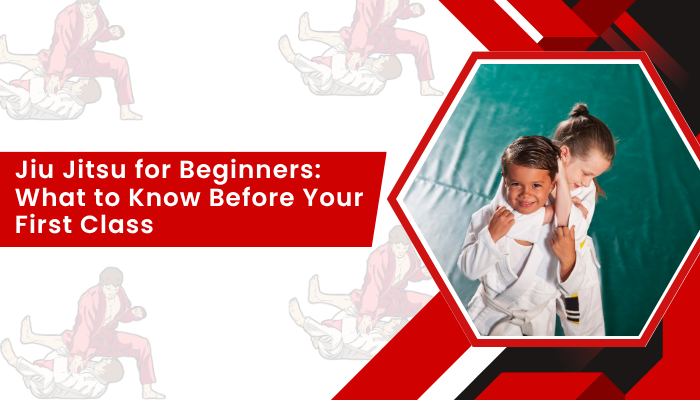Jiu Jitsu for Beginners: What to Know Before Your First Class
So, you’ve decided to try jiu jitsu. Maybe a friend talked you into it, maybe you’ve watched a few UFC...

So, you’ve decided to try jiu jitsu. Maybe a friend talked you into it, maybe you’ve watched a few UFC fights and got curious, or maybe you’re simply looking for a new way to move your body and challenge your mind. Whatever brought you here, welcome- you’re about to enter a world that’s as humbling as it is rewarding.
Walking into your first jiu jitsu class can be intimidating. There are people rolling around on the mat, using words like “guard” and “kimura,” and everyone seems to already know what they’re doing. But here’s a little secret: every single person in that room was once a beginner too. No one’s born knowing how to shrimp or escape side control. That’s the beauty of jiu jitsu- it’s a journey, and it starts with showing up.
In this guide, we’ll cover everything you need to know before your first jiu jitsu class. From what to wear to what mindset to bring, you’ll walk in prepared and, hopefully, a little less nervous.
What Is Jiu Jitsu, Really?
Let’s start with the basics. Jiu jitsu, more specifically, Brazilian Jiu Jitsu (BJJ)- is a grappling-based martial art that focuses on ground fighting and submissions. Unlike striking arts like boxing or karate, jiu jitsu emphasizes technique, leverage, and strategy to control and subdue opponents, often regardless of size or strength.
That means a smaller person, with proper technique, can control or even submit a much larger opponent. This is one of the main reasons jiu jitsu is so appealing- not just for self-defense, but also as a physical and mental discipline.
In practice, you’ll learn:
- Takedowns and sweeps
- Position control (like mount, guard, and back control)
- Submissions (armbars, chokes, joint locks)
- Escapes and defenses
At its core, jiu jitsu is like human chess. You’re constantly solving problems, anticipating your partner’s next move, and adapting in real time.
What to Expect in Your First Jiu Jitsu Class
Let’s be honest- your first class might feel like drinking from a firehose. And that’s okay.
Most beginner-friendly jiu jitsu academies will follow a structure like this:
- Warm-Up
Expect movements like shrimping, bridging, and rolling. These drills mimic actual movements used during live sparring, so they’re functional, not just fitness-focused. - Technique Instruction
Your coach will demonstrate a technique (like a guard pass or submission), then you’ll practice it with a partner. Don’t worry if it doesn’t click right away- repetition is key. - Drilling or Positional Training
You may do light resistance drills where you and your partner try to apply the technique in a controlled way. - Rolling (Sparring)
Not every beginner class includes sparring, but if it does, it’ll be at a light, friendly pace. Rolling is where you apply what you’ve learned in a live setting- but again, safety is the priority. - Cool Down and Questions
Many instructors leave time at the end to answer questions, discuss technique, or offer encouragement.
What You’ll Need (And What You Don’t)
If you’re nervous about gear- don’t be. Most academies have loaner gis (uniforms) or let you train in athletic wear for your first few classes. But if you’re ready to invest, here’s what you’ll need:
Gi Class:
- Gi (Kimono): A thick cotton uniform designed for grappling
- White Belt: Most beginners start here; it often comes with your gi
- Rash Guard (optional): Worn under the gi for comfort and hygiene
- Flip-Flops: To wear off the mat (mat hygiene is a big deal)
No-Gi Class:
- Rash Guard or Compression Shirt
- Grappling Shorts or Spats: No zippers or pockets
- Mouthguard (recommended)
More importantly, bring:
- An open mind
- A humble attitude
- Water and a towel
- Willingness to make mistakes- and learn from them
Tips for Making the Most of Your First Few Classes
- You don’t need to be in shape to start.
Starting jiu jitsu is how many people get in shape. Your conditioning will improve over time. Just show up. - Tap early, tap often.
Tapping out isn’t a sign of weakness- it’s a sign you’re training smart and safely. You’ll learn more by tapping than by resisting and getting hurt. - Ask questions, but don’t coach.
Instructors are there to guide you. Your training partner is not. Likewise, once you get a little experience, avoid trying to “teach” others unless asked. - Be consistent.
Progress in jiu jitsu is slow and often invisible at first. Don’t chase perfection- chase consistency. - Leave your ego at the door.
You’ll get submitted by smaller people. You’ll forget techniques. You’ll feel frustrated. That’s all part of the process.
Why Jiu Jitsu Is Worth the Effort
There will be days when you wonder why you’re doing this. Your body will be sore. Your brain will feel overloaded. But then there will be a moment, a sweep you nail, an escape you’ve been drilling that finally works- when it clicks.
That feeling is addictive. And it builds over time.
Jiu jitsu teaches more than just self-defense. It teaches discipline, patience, humility, and resilience. You’ll face your limitations- and overcome them. You’ll learn to breathe through discomfort, to think under pressure, and to persevere.
And the best part? You’ll do it all within a supportive community of people who are walking the same path.
Final Thoughts
If you’re reading this as a parent wondering whether jiu jitsu is right for your child, the answer is a resounding yes. Kids who start training early develop incredible physical coordination, social skills, and confidence. They learn how to handle pressure, resolve conflict, and believe in their own progress- without needing to “win” every time.
Many academies offer specialized jiu jitsu for kids programs that are safe, fun, and age-appropriate. And watching a child grow through the ranks is one of the most rewarding experiences, both for the child and the parent.
Change block type or style
Move Paragraph block from position 2 up to position 1
Move Paragraph block from position 2 down to position 3
Change text alignment
Displays more block tools
blob:https://thenewsus.com/b08c435d-5083-4c06-84f5-3f2fa4747b10
So whether you’re starting your own journey or helping your child begin theirs, know this: every black belt was once a beginner who showed up to that first class with a mix of nerves and excitement- just like you.
Welcome to the journey. You’ve got this.
Click – thenewsus.com



